PRESTO PLANS
Sent straight to your inbox
CLICK HERE TO ACCESS
Sign up to receive 10 ready-to-use ELA resources your students will love!
10 FREE ELA RESOURCES
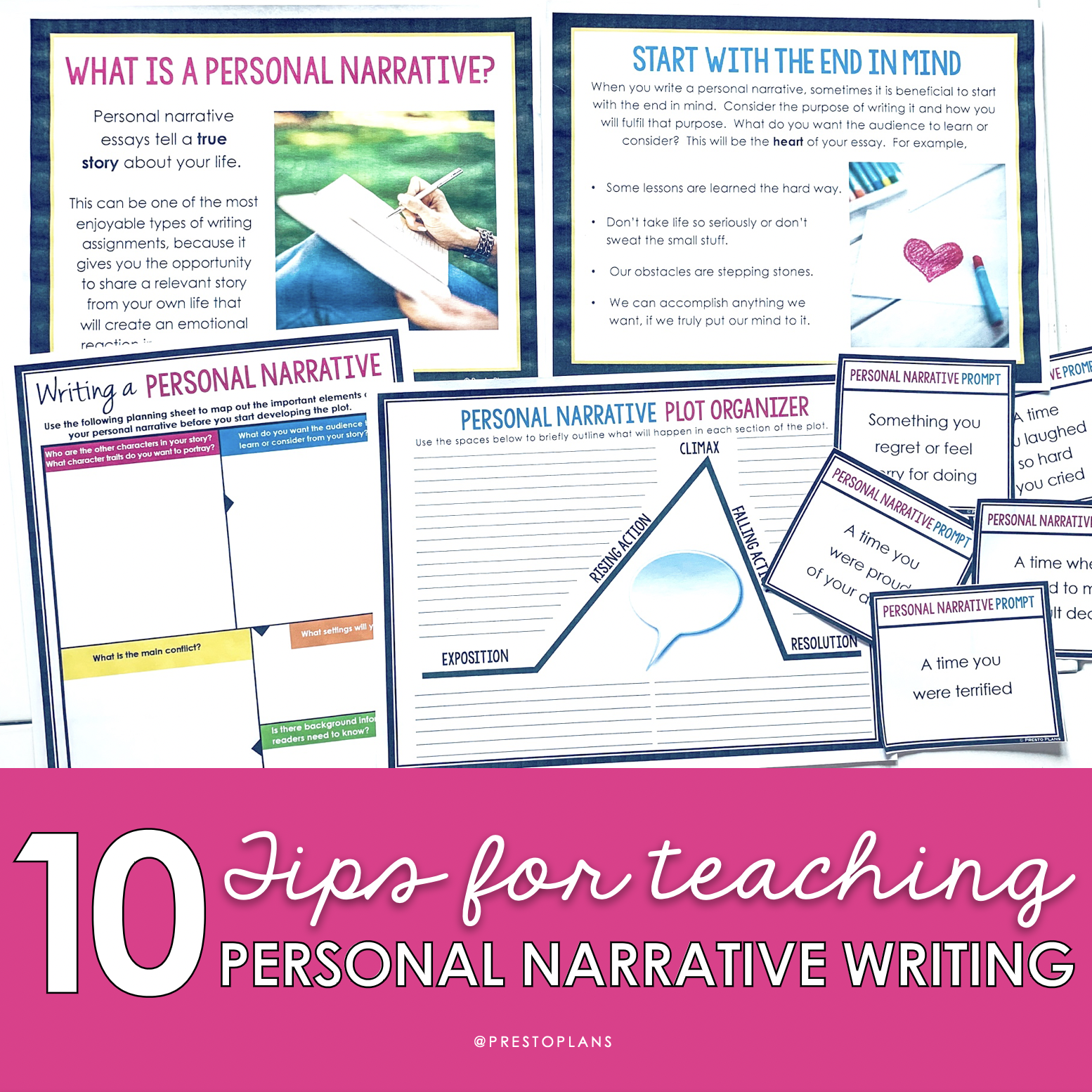
10 Tips for Teaching Personal Narrative Writing in Middle School ELA
One of my favorite middle school ELA writing activities for the beginning of the school year is a personal narrative essay. I find this assignment is a great way for us to learn a lot about who our students are – as writers, and as people! It’s a great way to build foundational relationships with new students and set everyone up for a positive year!
Here’s how I like to set up personal narrative essay writing in the classroom:
1. Teach about the Genre
To begin, I like to explore the idea of personal narrative writing. While many of our middle school ELA students have written other types of essays before, this is often the first time they encounter this the personal narrative writing genre. First, I like to ask students if they have ever heard of personal essays and guide a brief class discussion.
Personal narratives create a valuable opportunity for students to share relevant stories from their own lives. Usually, this type of writing is designed to provoke an emotional reaction. Often, they find that personal narratives can be one of the most enjoyable writing assignments in ELA class!
2. Help them Choose a Topic
I find that one of our students’ biggest roadblocks to writing a personal narrative essay is the fact they think they don’t have anything worthwhile to say!
When this inevitably happens, I like to remind them that personal narratives can encompass a broad range of topics. As they plan their writing, they can choose to write about a single event, or an overall experience. For example, they might like to highlight on a moment in time. Alternatively, they could focus on a single thing that spanned a number of years (developing a skill at swimming lessons or dance class, for example). Even the simplest story can make an excellent topic for a personal narrative essay, as long as it is presented in a powerful way.
I also like to emphasize that the most important part of a personal narrative is that the writing has a purpose. For example:
- A funny story might enlighten readers on a lesson learned the hard way.
- A scary story might serve as a warning or wake up call.
- A touching story might inspire others to be a better person or view the world from a different perspective.
Sometimes I even like to share one of my favorite quotes. The saying (which is often attributed to the Dalai Lama) goes, “If you think you’re too small to make a difference, try sleeping with a mosquito!” This usually reassures our middle school ELA students that we all have the ability to make a powerful impact!
If they are stuck…
If the class still seems stuck on choosing a topic, I like to set stations up around the room and break students into small groups. Next, I provide them with task card prompts at each station to get them thinking about their various life experiences that might make a good topic for a personal narrative essay.
When they arrive at each station, they read the card. Each member of the group briefly shares a story that relates to the prompt, and students take a few minutes to jot down a few possible ideas on their brainstorming sheet. As they move through the stations and repeat the process, they should generate a number of different ideas to consider.
When their sheet is full, I invite them to narrow down their choices by considering their answers to the following questions:
- What are you most inspired by or excited to write about?
- What might be the most interesting for others to read?
- Which topic can be told with a clear series of events and interesting details or enticing descriptions?
- Which story has a thought-provoking message or point?
3. Share Two Important Questions
As the class works through the brainstorming process, they need to also consider the fact that personal narrative essays are meant to be shared with others. I will read their work when I grade it, of course, and I also like to share and display students’ writing around my classroom.
With this in mind, I like to invite students to consider two questions before they get too deep into their initial draft:
- Am I comfortable sharing this story with others?
- Will people be able to relate to my experiences and what I learned?
When thinking about these questions, if the student cannot respond with an enthusiastic “yes” to both, it is time to go back to the brainstorming sheet and choose a different topic. But if their topic passes this important self-check, they can keep going!
4. Start With the End in Mind
Now, it’s time for students to step back and consider the purpose of their writing. In this section of the lesson, I encourage the middle school ELA class to think about the “heart” of the story. In other words, what do they want the audience to notice and consider as they read?
This is also an opportunity for students to consider their own purpose for writing. Some questions I like to ask are:
- Why do you want to share this story?
- What do you want people to feel as they read your personal narrative essay?
- What should the lasting impression of this story be on your reader?
5. Consider Your Audience
As part of the pre-planning process, I also like to remind middle schoolers of who their audience for this task will be. After all, personal stories should be shared with others!
I find that sometimes students approach an assignment from a different perspective depending on who will be reading their written work. This is why I like to make it very clear about the audience for their finished writing upfront.
There are many options for sharing students’ written work. Sometimes, after the essays are written, I have students sit and read them aloud to small groups of their peers. I also usually invite them to include their personal narratives in their portfolio of work from the year, which can be accessed by parents and guardians through an online portal. I may also keep a copy of their personal narratives to share with families during student-led conferences.
In some cases, a conversation with students about how they would like their words and ideas to be shared can be useful. They may surprise you with their own ideas. For example, they might like to post excerpts from their personal narratives to a blog, or even make them into a podcast!
6. Plan Out Your Story Elements
Once you have addressed the issues of topic and audience, it’s time to consider the elements of a personal narrative.
Characters:
I like to emphasize that while the writer is the main character, a personal narrative essay usually involves other characters as well. When preparing to write, I invite students to consider:
- Who else is involved in the story or event?
- What are their character traits, and how will you show them through your writing?
- What is your relationship like with this person (or people?)
Setting:
Once the characters are established, a next step for students is to consider the setting. For example, if location is important to the story, I might ask the class how they will convey a sense of place.
Here, I find it helps to brainstorm sensory details to include. I like to ask the class about the weather, time of day, sounds (for example, birds chirping, crowds, rain on the roof) and other details. These can help add color to the overall scene.
Conflict:
During the lesson, I like to explain that most personal narratives include one of the four types of conflict. This is sometimes new information for my middle school ELA students! I find it helps to ask the following questions:
- Is there conflict between you and another person in the story? (person vs. person)
- Are you struggling with some type of inner turmoil or struggling to make a decision? (person vs. self)
- Are you in conflict with the natural elements? (person vs. environment)
- Are you challenging an element of government or society? (person vs. society)
7. Provide an Organizational Framework
As we discuss the organizational framework of a personal narrative essay, middle school ELA students usually notice similarities to traditional story writing. During this process, a graphic organizer can support them with their planning.
Planning the Beginning of the Essay:
I remind them that the beginning of their essay should provide a captivating hook, establishing the basic details of the story. This can include background information, as well as information about the characters and setting. Most importantly, I like to reinforce that this is where they need to establish themselves as the main character! Depending on the topic, the students might introduce the conflict in this section as well.
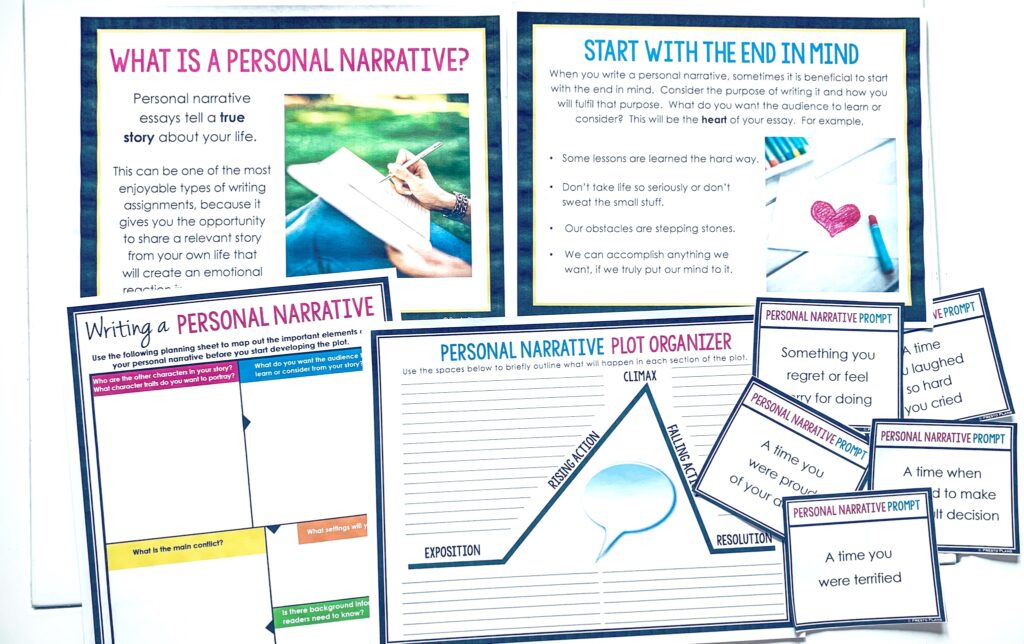
Planning the Middle of the Essay:
As they move on to the middle of the personal narrative, I like to tell middle school ELA students to dive even more deeply into the situation, problem, or event they are describing. This helps their reader connect with the story. To do this, I also like to invite them to consider the character’s experiences (how they were feeling and what they were thinking). Just like in traditional fiction, this is also the place to build to some kind of climax.
Planning the Conclusion of their Essay:
Finally, I have students consider how they plan to conclude their personal narrative writing ELA task. In this section, they will want to tie up any loose ends, and identify any key messages they want to leave with the reader. As they organize their ideas, I ask them to think about a few things:
- What could the reader learn from your experience?
- Is there a moral or lesson the reader might consider in their own life?
- Will your story leave the reader laughing, in tears, or ready to take action?
One thing I emphasize is that students who are unfamiliar with personal narrative writing will probably want to stick quite closely to this planning format at first. As they become more comfortable with this type of writing task, they will gain more confidence in their own style, and take more creative risks.
8. Share Writing Strategies
Now it’s time for the fun part – the writing itself! Before my middle school ELA students write their essays in earnest, I offer a few tips to get them started.
First, I remind them to write their narrative essays in first person. After all, they’re telling their own stories! We discuss the idea of being “true to your voice” as a writer, and consider how the students wish to tell their personal stories. A humorous, witty, inspiring or sad story will all require a different tone – and whatever direction the student chooses to go in, the writing should be consistent.
Next, I like to offer a few tips about engaging the reader. Dialogue can add color and vibrancy to a personal narrative. Vivid imagery and sensory details can show, rather than tell, a sense of place or emotional connection. I love sharing the sample sentence, “Her face flushed to a shocking shade of red.” This is much more effective than, “She was embarrassed.”
9. Allow Time For Peer Editing
In my classroom, I like to leave a period or two for peer editing and revisions at the end of the writing process.
The first time, I encourage ELA students to read their personal narrative writing aloud. Or – even better – they can have a peer read their work back to them. This is a great starting point for finding mistakes or weak spots in the writing that need to be changed. The second time through, students can use a checklist to edit the work in sections and offer suggestions for improvement.
By breaking the editing process down into three key areas (grammar, content, and writing structure), I find students can keep their feedback constructive, focused and efficient. Finally, I leave time for the students to go over their writing again, making spelling and grammar corrections to ensure they turn in their best work.
10. Give Options for Sharing
It’s important to remember that each student has their own personal comfort level about sharing their work with a large group. A brief survey (either on paper or via Google Forms) is a great way to check in on students and find out how they would like to share their writing.
Here are some choices I like to offer:
- sharing their personal narrative essay through a pre-recorded podcast or video
- reading their essay in front of the class
- presenting their work to a small group of their peers
- booking a private meeting with me (usually at lunch) to go through their essay together
There you have it! I hope your middle school ELA students love writing personal narrative essays as much as mine do!
If you’re looking for more unique writing ideas for middle and high school, check out 5 Outside the Box Creative Writing Assignments in ELA!
Students stuck in a writing rut? Here are 8 Ways to Engage Reluctant Writers.
Search the blog for what you are teaching
GIVEAWAYS
sent straight to your inbox!
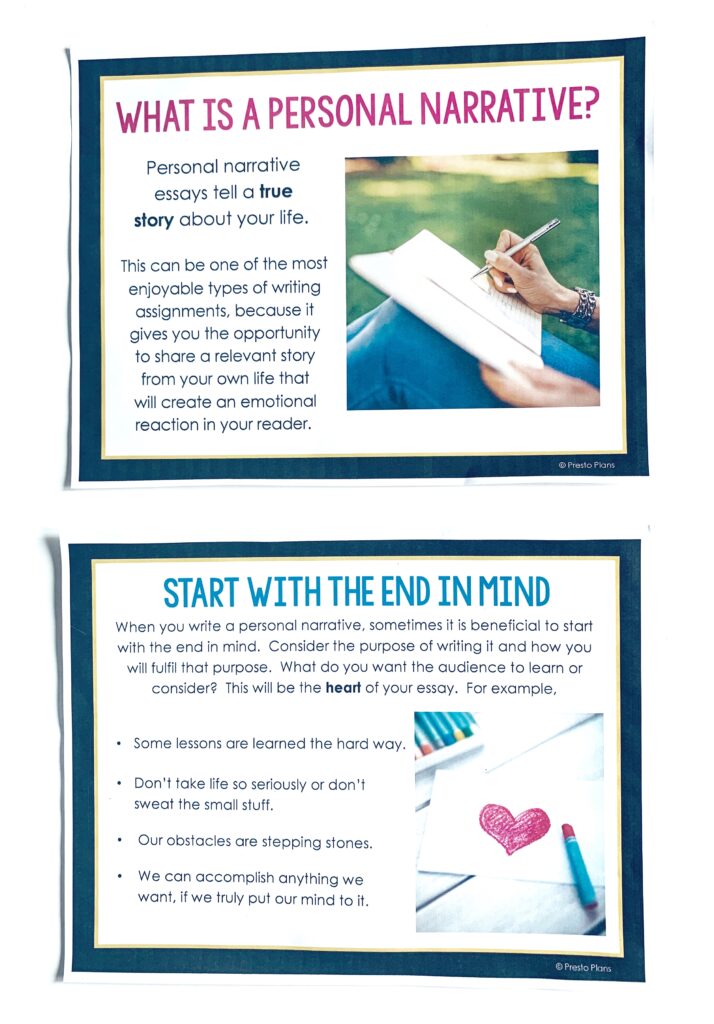
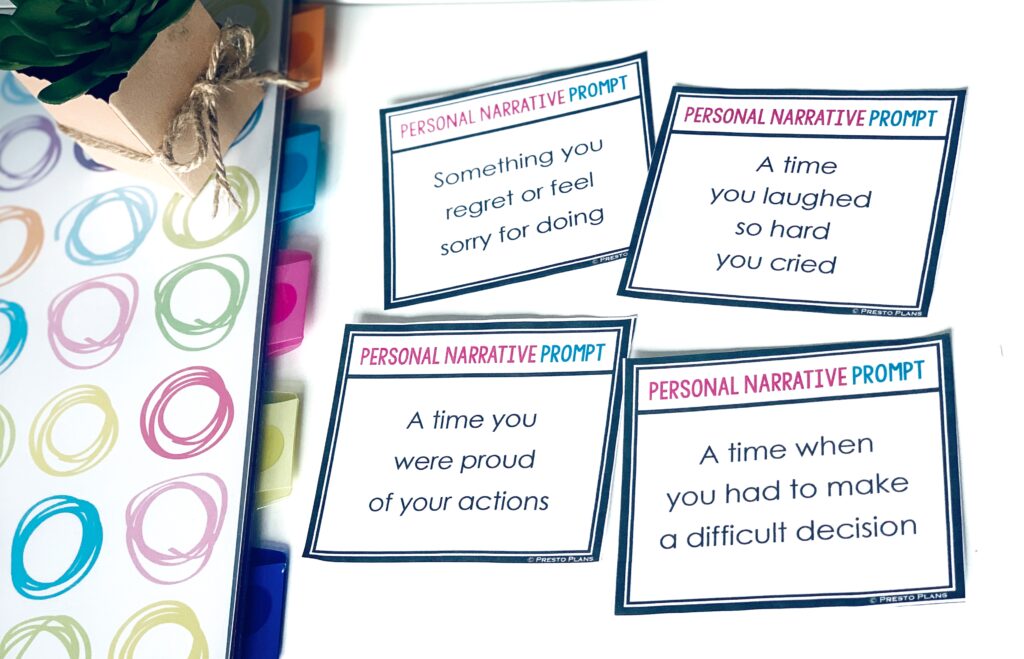
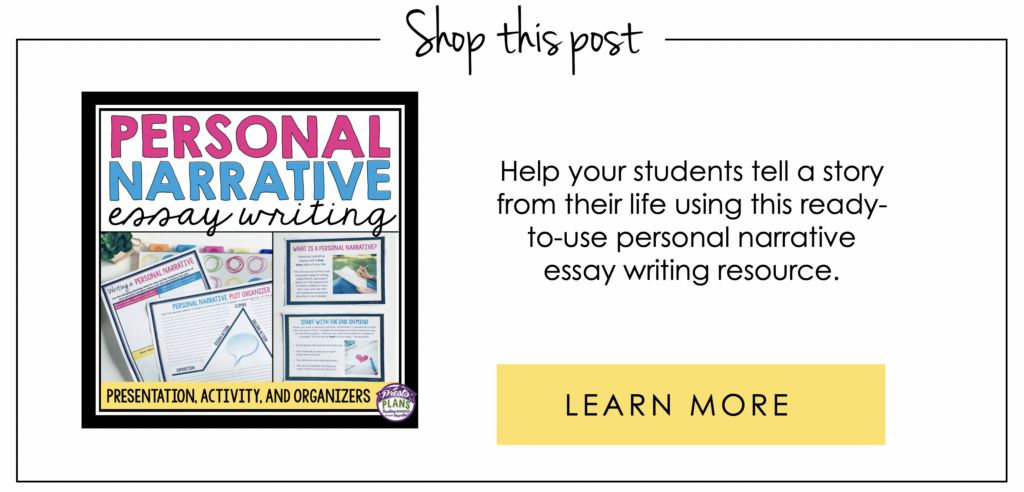
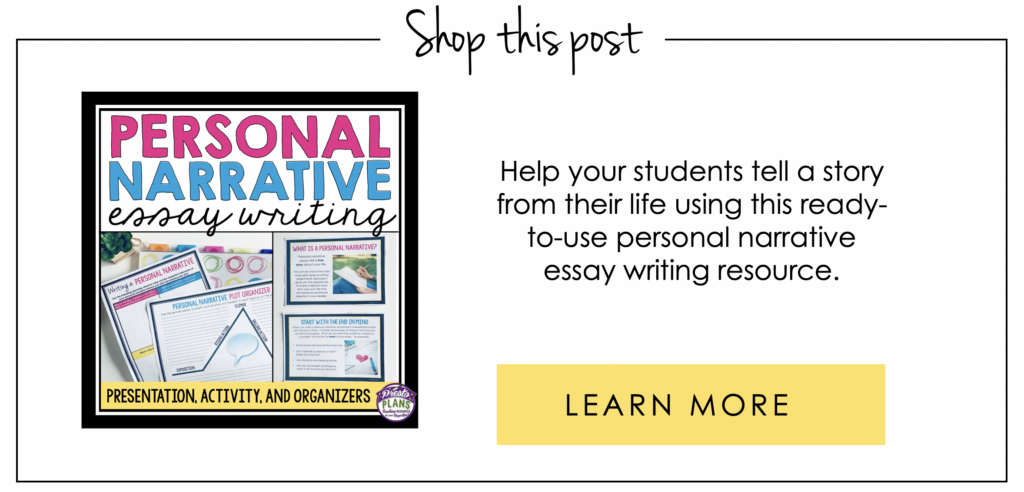
share this post